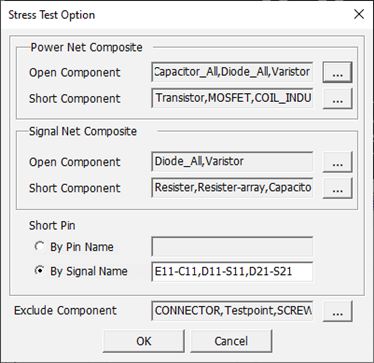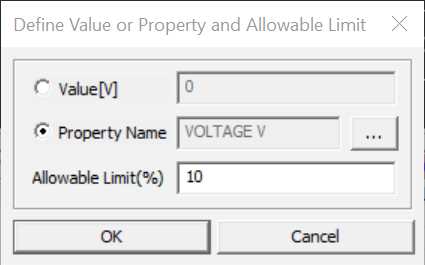Resistor
This item tracks the voltage and signal lines in the circuit, calculates the voltage value of each net, and checks whether the all resistor connected to the net is within the allowable voltage range.

Figure 1.
- Component: Select resistor component group to be checked.
- Comp Value
Property: Enter the value of resistance or select the property which contain
the value of resistance.

Figure 2. - Net: Select net group to which resistor components are connected.
- Power Net: Select power net group to which resistor components are connected.
- Ground Net: Select ground net group to which resistor components are connected.
- Voh: Set the output high voltage (Voh) of driver pin. You can set this by entering the value directly or select the property name which contain voh value.
- Vol: Set the output low voltage (Vol) of driver pin. You can set this by entering the value directly or select the property name which contain vol value.
- Working Voltage
Check: Set the allowable working voltage of this component. You can set this
by entering the allowable value directly or select the property name which
contain allowable working voltage value. You can also assign tolerance of
this check.
Figure 3. - Power Dissipation
Check: Set the allowable power dissipation value of this component. You can
set this by entering the allowable value directly or select the property
name which contain allowable power dissipation value. You can also assign
tolerance of this check.
Figure 4.
Stress Test Option

Figure 5.
- Open Component: Select the component group to be regarded as short when power trace navigating.
- Short Component:
Select the component group to be regarded as short when power trace
navigating.

Figure 6.
- Open Component: Select the component group to be regarded as short when signal trace navigating.
- Short Component:
Select the component group to be regarded as short when signal trace
navigating.

Figure 7.
- By Pin Name: Declare pin paring information as pin name. If there is more than one condition, the separator “,” is used.
- By Signal Name:
Declare pin paring information as signal name. If there is more than one
condition, the separator “,” is used.

Figure 8.

Figure 9.
